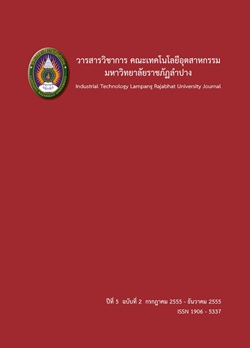แนวทางการบริหารจัดการขยะมูลฝอยแบบครบวงจรของจังหวัดลําปาง
Keywords:
การบริหารจัดการขยะแบบครบวงจร, การจัดการขยะ, ขยะ, Absolute refuse elimination, refuse elimination, refuseAbstract
การศึกษาแนวทางการบริหารจัดการขยะมูลฝอยแบบครบวงจรของจังหวัดลำปาง มีวัตถุประสงค์เพื่อศึกษาสถานการณ์เกี่ยวกับขยะมูลฝอยในปัจจุบันและอนาคตของจังหวัดลำปาง และแนวทางการบริหารจัดการขยะมูลฝอยแบบครบวงจรของจังหวัดลำปาง การศึกษาครั้งนี้ เป็นการศึกษาเชิงคุณภาพ โดยการสำรวจ รวบรวม ศึกษา และวิเคราะห์จากข้อมูลทุติยภูมิ ซึ่งในการ คาดการณ์ปริมาณขยะมูลฝอยจะใช้อัตราการเปลี่ยนแปลงปริมาณขยะเฉลี่ยที่เกิดขึ้นในปี 2548-2553 รวมทั้งอัตราการเปลี่ยนแปลงจำนวนประชากรเป็นปัจจัยในการศึกษาร่วมด้วย โดยนำข้อมูล ที่ได้มาวิเคราะห์หาแนวทางการบริหารจัดการขยะมูลฝอยแบบครบวงจร ซึ่งผลการศึกษาพบว่า จังหวัดลำปางมีอัตราการเกิดขยะเพิ่มขึ้นเฉลี่ยร้อยละ 0.174 ตันต่อปี แนวโน้มขยะมูลฝอย ของจังหวัดลำปางในอีก 10 ปีข้างหน้าซึ่งคาดการว่าปี 2563 จะมีปริมาณขยะมูลฝอยเพิ่มขึ้น เป็น 513.834 ตันต่อวัน (เฉลี่ยในแต่ละปีมีปริมาณขยะเกิดขึ้น 509.846 ตันต่อวัน) โดยขยะมูลฝอย ส่วนใหญ่เป็นเศษอาหารคิดเป็นร้อยละ 24.49 โดยการนำขยะมูลฝอยกลับมาใช้ประโยชน์ใหม่เพียง ร้อยละ 16.793
ปัจจุบันจังหวัดลำปางมีระบบการจัดการขยะมูลฝอยที่ยังไม่มีประสิทธิภาพ พบว่า มีการเก็บ ขยะโดยไม่มีการคัดแยกเฉลี่ยวันละ 4.10 ตัน กำจัดโดยการเทกองในบ่อดินไม่มีรั้วกั้น มีการเผา Open dump ซึ่งไม่เป็นตามหลักสุขาภิบาลไม่มีการฝังกลบที่ถูกหลักสุขาภิบาล ในที่ดินสาธารณะ ประโยชน์ ส่งผลกระทบด้านสิ่งแวดล้อมและชุมชน มีการเก็บค่าธรรมเนียมขยะเดือนละ 5 - 30 บาท ฉะนั้นเพื่อเพิ่มประสิทธิภาพ ควรวางแนวทางการบริหารจัดการขยะมูลฝอยแบบครบวงจร ของจังหวัดลำปางโดยการบูรณาการความร่วมมือในทุกภาคส่วน ใช้เทคโนโลยีผสมผสานภายใต้ แนวคิดขยะเป็นศูนย์ ลด/คัดแยกขยะตั้งแต่แหล่งกำเนิดขยะ และจัดตั้งศูนย์รวบรวมขยะ ซึ่งแนวคิด ดังกล่าวจะทำให้จังหวัดลำปางสามารถลดปริมาณขยะที่ต้องเข้าสู่ศูนย์รวบรวมขยะร้อยละ 41.891 (213.578 ตัน) และเมื่อเข้าสู่กระบวนการของศูนย์รวบรวมขยะจะเหลือขยะที่ต้องกำจัดด้วยวิธีการ ที่เหมาะสม ร้อยละ 28.852 (147.101 ตัน)
The Complete Elimination of Waste in Lampang Province
This research studied a waste management in Lampang province by looking at the waste situation both at present and in the future as well as the building of a waste management system. This study was carried out by surveying and analyzing secondary data. The study also incorporated data on average waste quantities from 2006-2010 and the rate of change in population in order to predict the amount of waste in the future.
The result showed that Lampang has an average increase in waste of 0.174 tons per year. By 2020, Lampang will produce 513.834 tons of waste per day. 24.49 per cent of the waste was from food. Only 16.793 per cent of the waste had been reused.
At present, Lampang does not have an effective waste disposal system. It was found that 4.10 tons of waste were collected daily without sorting. The waste was dumped into a site with no-fencing earth walls. There was no sanitation when burning waste in the open and the burning of waste on public lands affected the community and the environment.
At the moment, each household spent 5-10 baht for waste disposal services. In order to establish a waste management system, waste should be reduced and sorted at its source before it arrives at the waste disposal centre. This could help reduce waste going to the waste disposal centre to 41.891 per cent (or 213.578 tons) of the current level and there will be only 28.852 per cent (or 147.101 tons) of the waste disposal process.






